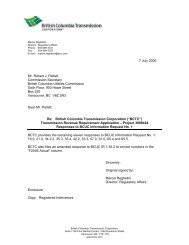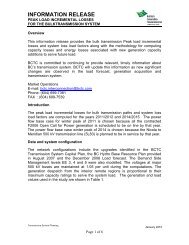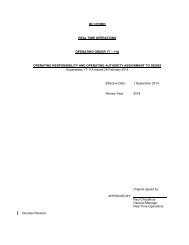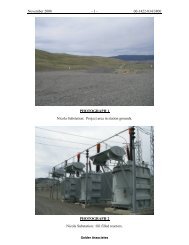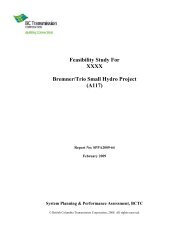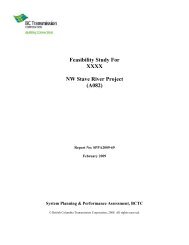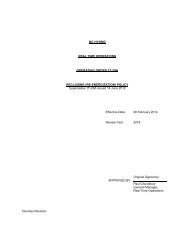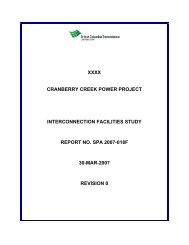Evidence on the Adequacy of First Nations Consultation - BC Hydro ...
Evidence on the Adequacy of First Nations Consultation - BC Hydro ...
Evidence on the Adequacy of First Nations Consultation - BC Hydro ...
Create successful ePaper yourself
Turn your PDF publications into a flip-book with our unique Google optimized e-Paper software.
Shuswaps described in <strong>the</strong> H<strong>BC</strong> records dating from <strong>the</strong> 1820s, 64 <strong>the</strong> book shows how “Kinbasket”<br />
could still be actively travelling through <strong>the</strong> mountains with Provincial Surveyors nearly half a<br />
century later.<br />
The book asserts that this band spent a number <strong>of</strong> years living in <strong>the</strong> vicinity <strong>of</strong> <strong>the</strong> Boat<br />
Encampment, and that oral traditi<strong>on</strong> describes how busy a place it was with comings and goings <strong>of</strong><br />
many kinds <strong>of</strong> people, including priests. This again is c<strong>on</strong>sistent with <strong>the</strong> use <strong>of</strong> Boat Encampment<br />
by <strong>the</strong> fur trade, especially from <strong>the</strong> 1820s <strong>on</strong>, as a key stop <strong>on</strong> <strong>the</strong> route known as <strong>the</strong> Columbia<br />
Express and <strong>the</strong> employment by <strong>the</strong> H<strong>BC</strong> <strong>of</strong> Shuswaps as packers, hunters and guides. The claim<br />
that Yelheelna met David Thomps<strong>on</strong> <strong>the</strong>refore becomes plausible, and ties in with suggesti<strong>on</strong>s that<br />
<strong>the</strong>se Kinbasket Shuswaps were present in <strong>the</strong> area <strong>of</strong> Boat Encampment by 1811.<br />
According to Dehart, <strong>the</strong> migrati<strong>on</strong> began as an explorati<strong>on</strong> <strong>of</strong> some young Shuswap men from <strong>the</strong><br />
Adams Lake area [pp. 28-29]:<br />
They were really exploring and so <strong>the</strong>y went north <strong>on</strong> Kinbasket Lake up to Canoe Reach and <strong>on</strong> to<br />
Valem<strong>on</strong>t. They explored all <strong>of</strong> Kinbasket Lake <strong>on</strong> both sides. They camped for a few days before<br />
<strong>the</strong>y got to <strong>the</strong> Columbia River. From <strong>the</strong>re <strong>the</strong>y crossed <strong>the</strong> river and kept following <strong>the</strong> shore. They<br />
again camped at Downie Creek where it enters <strong>the</strong> Columbia River for quite some time. They were<br />
away from <strong>the</strong>ir people a l<strong>on</strong>g time and when <strong>the</strong>y went home, <strong>the</strong>y told <strong>the</strong> people about it. The Elders<br />
told <strong>the</strong>m “That’s Kootenay Country, very dangerous”.<br />
_____ _____ _____<br />
The Elders tried to stop <strong>the</strong> explorers, <strong>the</strong>y forbad <strong>the</strong>m to keep going into enemy territory, <strong>the</strong><br />
dangerous Kootenay Country but <strong>the</strong> young <strong>on</strong>es c<strong>on</strong>tinued to explore.<br />
Eventually <strong>the</strong> explorers grew into a band, with Yeheelna as <strong>the</strong>ir chief, staying for some time at <strong>the</strong><br />
Boat Encampment and making occasi<strong>on</strong>al forays southward up <strong>the</strong> Columbia Valley. The Shuswaps<br />
were evidently fearful that <strong>the</strong>y would be attacked for encroaching <strong>on</strong> Ktunaxa territory and <strong>the</strong>n very<br />
happy with ultimate acceptance into <strong>the</strong> nor<strong>the</strong>rly porti<strong>on</strong> <strong>of</strong> <strong>the</strong> Ktunaxa’s territory. Referring to <strong>the</strong><br />
meeting that established peace between <strong>the</strong>m, deHart indicates that <strong>the</strong> main body <strong>of</strong> <strong>the</strong> Kinbaskets<br />
were camped at <strong>the</strong> c<strong>on</strong>fluence <strong>of</strong> <strong>the</strong> Beaver and Columbia Rivers at that time, with a smaller group<br />
including Chief Yeheelna camping fur<strong>the</strong>r upstream near present day D<strong>on</strong>ald [p. 33]. According to<br />
her book, <strong>the</strong> Ktunaxa had watched <strong>the</strong> Shuswap for a l<strong>on</strong>g time before <strong>of</strong>fering Yeheelna and his<br />
small group a welcome and friendship through <strong>the</strong> making <strong>of</strong> signs and <strong>of</strong>fering <strong>of</strong> gifts [p.34].<br />
Dehart <strong>the</strong>n indicates that <strong>the</strong> Ktunaxa c<strong>on</strong>tinued to freely hunt or travel <strong>the</strong>re, <strong>of</strong>ten in <strong>the</strong> company<br />
<strong>of</strong> <strong>the</strong>ir new neighbours.<br />
Regarding <strong>the</strong> founding <strong>of</strong> <strong>the</strong> Kinbasket settlement Dehart goes <strong>on</strong> to say:<br />
The Indians met <strong>the</strong> Morigeau’s [sic] near Windermere Creek sometime before 1840. The first priest<br />
Fa<strong>the</strong>r de Smet came in 1845. He baptized <strong>the</strong> Morigeau children and a few Indian children, am<strong>on</strong>g<br />
<strong>the</strong>m Chief Pierre’s oldest daughter Maras. 65 The Kinbasket’s and <strong>the</strong> Morigeau’s [sic] were already<br />
settled here before that. The Weir’s settled after that but <strong>the</strong>y all had met <strong>the</strong> Shuswaps before <strong>the</strong><br />
priests came.<br />
64 For example, <strong>the</strong> Kamloops – North Thomps<strong>on</strong> Journal entry for November 8, 1822, menti<strong>on</strong>s “<strong>the</strong> old North Branch<br />
Chief…and family are in <strong>the</strong> habit <strong>of</strong> going some times to <strong>the</strong> east <strong>of</strong> <strong>the</strong> Rocky Mountains & Jaspers House…”<br />
65 This reference to Chief Pierre is likely incorrect, unless he had a daughter at a very young age. O<strong>the</strong>r parts <strong>of</strong> her<br />
account indicate <strong>the</strong> Chief at this time was Paul Neass.<br />
26<br />
Page 170 <strong>of</strong> 200






